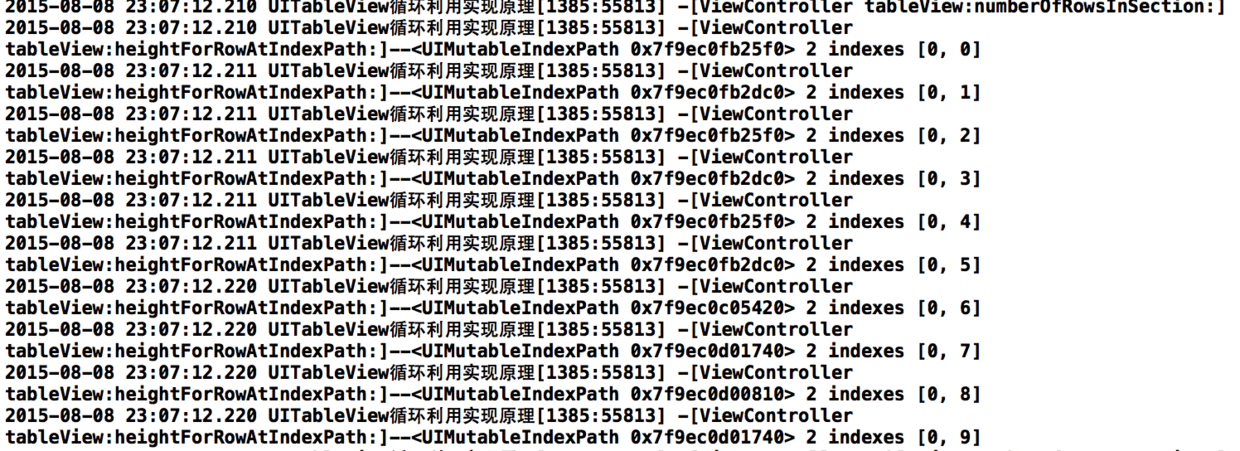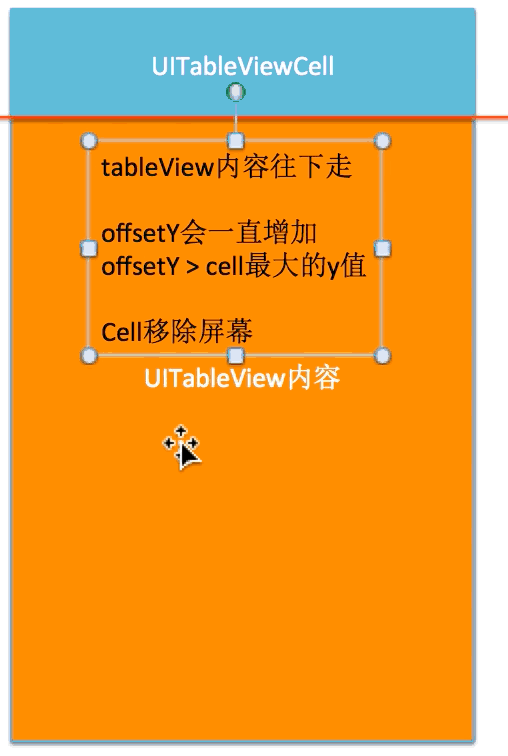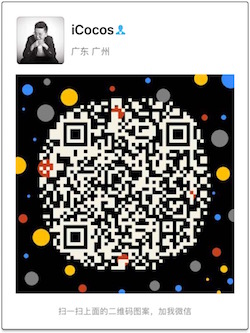- 前言
大家都知道UITableView,最经典在于循环利用,这里我自己模仿UITableView循环利用,写了一套自己的TableView实现方案,希望大家看了我的文章,循环利用思想有显著提升。
一: 研究UITableView底层实现
1.系统UITabelView的简单使用,这里就不考虑分组了,默认为1组。
1 // 返回第section组有多少行
2 - (NSInteger)tableView:(UITableView *)tableView numberOfRowsInSection:(NSInteger)section
3 {
4 NSLog(@"%s",__func__);
5 return 10;
6 }
7
8 // 返回每一行cell的样子
9 - (UITableViewCell *)tableView:(UITableView *)tableView cellForRowAtIndexPath:(NSIndexPath *)indexPath
10 {
11 NSLog(@"%s",__func__);
12 static NSString *ID = @"cell";
13 UITableViewCell *cell = [tableView dequeueReusableCellWithIdentifier:ID];
14
15 if (cell == nil) {
16
17 cell = [[UITableViewCell alloc] initWithStyle:UITableViewCellStyleDefault reuseIdentifier:ID];
18 }
19
20 cell.textLabel.text = [NSString stringWithFormat:@"%ld",indexPath.row];
21
22 return cell;
23 }
24 // 返回每行cell的高度
25 - (CGFloat)tableView:(UITableView *)tableView heightForRowAtIndexPath:(NSIndexPath *)indexPath
26 {
27 NSLog(@"%s--%@",__func__,indexPath);
28 return 100;
29 }
2.验证UITabelView的实现机制。
如图打印结果:

分析:底层先获取有多少cell(10个),在获取每个cell的高度,返回高度的方法一开始调用10次。
- 目的:确定tableView的滚动范围,一开始计算所有cell的frame,就能计算下tableView的滚动范围。
分析:tableView:cellForRowAtIndexPath:方法什么时候调用。
打印验证,如图:

一开始调用了7次,因为一开始屏幕最多显示7个cell
- 目的:一开始只加载显示出来的cell,等有新的cell出现的时候会继续调用这个方法加载cell。
3.UITableView循环利用思想
当新的cell出现的时候,首先从缓存池中获取,如果没有获取到,就自己创建cell。
当有cell移除屏幕的时候,把cell放到缓存池中去。
二、自定义UIScroolView,模仿UITableView循环利用
1.提供数据源和代理方法,命名和UITableView一致。
1 @class YZTableView;
2 @protocol YZTableViewDataSource
3
4 @required
5
6 // 返回有多少行cell
7 - (NSInteger)tableView:(YZTableView *)tableView numberOfRowsInSection:(NSInteger)section;
8
9
10 // 返回每行cell长什么样子
11 - (UITableViewCell *)tableView:(YZTableView *)tableView cellForRowAtIndexPath:(NSIndexPath *)indexPath;
12
13 @end
14
15 @protocol YZTableViewDelegate
16
17 // 返回每行cell有多高
18 - (CGFloat)tableView:(YZTableView *)tableView heightForRowAtIndexPath:(NSIndexPath *)indexPath;
19
20 @end
2.提供代理和数据源属性
1 @interface YZTableView : UIScrollView
2
3 @property (nonatomic, weak) id dataSource;
4
5 @property (nonatomic, weak) id delegate;
6
7 @end
警告:

解决,在YZTableView.m的实现中声明。

原因:有人会问为什么我要定义同名的delegate属性,我主要想模仿系统的tableView,系统tableView也有同名的属性。
- 思路:这样做,外界在使用设置我的tableView的delegate,就必须遵守的我的代理协议,而不是UIScrollView的代理协议。
3.提供刷新方法reloadData,因为tableView通过这个刷新tableView。
1 @interface YZTableView : UIScrollView
2
3 @property (nonatomic, weak) id dataSource;
4
5 @property (nonatomic, weak) id delegate;
6
7 // 刷新tableView
8 - (void)reloadData;
9
10 @end
4.实现reloadData方法,刷新表格
回顾系统如何刷新tableView
1).先获取有多少cell,在获取每个cell的高度。因此应该是先计算出每个cell的frame.
2).然后再判断当前有多少cell显示在屏幕上,就加载多少
1 // 刷新tableView
2 - (void)reloadData
3 {
4 // 这里不考虑多组,假设tableView默认只有一组。
5
6 // 先获取总共有多少cell
7 NSInteger rows = [self.dataSource tableView:self numberOfRowsInSection:0];
8
9 // 遍历所有cell的高度,计算每行cell的frame
10 CGRect cellF;
11 CGFloat cellX = 0;
12 CGFloat cellY = 0;
13 CGFloat cellW = self.bounds.size.width;
14 CGFloat cellH = 0;
15 CGFloat totalH = 0;
16
17 for (int i = 0; i < rows; i++) {
18
19 NSIndexPath *indexPath = [NSIndexPath indexPathForRow:i inSection:0];
20 // 注意:这里获取的delegate,是UIScrollView中声明的属性
21 if ([self.delegate respondsToSelector:@selector(tableView:heightForRowAtIndexPath:)]) {
22 cellH = [self.delegate tableView:self heightForRowAtIndexPath:indexPath];
23 }else{
24 cellH = 44;
25 }
26 cellY = i * cellH;
27
28 cellF = CGRectMake(cellX, cellY, cellW, cellH);
29
30 // 记录每个cell的y值对应的indexPath
31 self.indexPathDict[@(cellY)] = indexPath;
32
33 // 判断有多少cell显示在屏幕上,只加载显示在屏幕上的cell
34 if ([self isInScreen:cellF]) { // 当前cell的frame在屏幕上
35 // 通过数据源获取cell
36 UITableViewCell *cell = [self.dataSource tableView:self cellForRowAtIndexPath:indexPath];
37
38 cell.frame = cellF;
39
40 [self addSubview:cell];
41
42 }
43
44 // 添加分割线
45 UIView *divideV = [[UIView alloc] initWithFrame:CGRectMake(0, cellY + cellH - 1, cellW, 1)];
46 divideV.backgroundColor = [UIColor lightGrayColor];
47 divideV.alpha = 0.3;
48 [self addSubview:divideV];
49
50 // 添加到cell可见数组中
51 [self.visibleCells addObject:cell];
52
53 // 计算tableView内容总高度
54 totalH += cellY + cellH;
55
56 }
57
58 // 设置tableView的滚动范围
59 self.contentSize = CGSizeMake(self.bounds.size.width, totalH);
60
61 }
5.如何判断cell显示在屏幕上
当tableView内容往下走

当tableView内容往上走

1 // 根据cell尺寸判断cell在不在屏幕上
2 - (BOOL)isInScreen:(CGRect)cellF
3 {
4 // tableView能滚动,因此需要加上偏移量判断
5
6 // 当tableView内容往下走,offsetY会一直增加 ,cell的最大y值 < offsetY偏移量 ,cell移除屏幕
7 // tableView内容往上走 , offsetY会一直减少,屏幕的最大Y值 < cell的y值 ,Cell移除屏幕
8 // 屏幕最大y值 = 屏幕的高度 + offsetY
9
10 // 这里拿屏幕来比较,其实是因为tableView的尺寸我默认等于屏幕的高度,正常应该是tableView的高度。
11 // cell在屏幕上, cell的最大y值 > offsetY && cell的y值 < 屏幕的最大Y值(屏幕的高度 + offsetY)
12
13 CGFloat offsetY = self.contentOffset.y;
14
15 return CGRectGetMaxY(cellF) > offsetY && cellF.origin.y < self.bounds.size.height + offsetY;
16
17 }
6.在滚动的时候,如果有新的cell出现在屏幕上,先从缓存池中取,没有取到,在创建新的cell.
- 分析:
需要及时监听tableView的滚动,判断下有没有新的cell出现。
大家都会想到scrollViewDidScroll方法,这个方法只要一滚动scrollView就会调用,但是这个方法有个弊端,就是tableView内部需要作为自身的代理,才能监听,这样不好,有时候外界也需要监听滚动,因此自身类最好不要成为自己的代理。(设计思想)
- 解决:
重写layoutSubviews,判断当前哪些cell显示在屏幕上。
因为只要一滚动,就会修改contentOffset,就会调用layoutSubviews,其实修改contentOffset,内部其实是修改tableView的bounds,而layoutSubviews刚好是父控件尺寸一改就会调用.具体需要了解scrollView底层实现。
- 思路:
判断下,当前tableView内容往上移动,还是往下移动,如何判断,取出显示在屏幕上的第一次cell,当前偏移量 > 第一个cell的y值,往下走。
需要搞个数组记录下,当前有多少cell显示在屏幕上,在一开始的时候记录.
1 @interface YZTableView ()
2
3 @property (nonatomic, strong) NSMutableArray *visibleCells;
4
5 @end
6
7 @implementation YZTableView
8
9 @dynamic delegate;
10
11 - (NSMutableArray *)visibleCells
12 {
13
14 if (_visibleCells == nil) {
15 _visibleCells = [NSMutableArray array];
16 }
17 return _visibleCells;
18
19 }
20 @end
往下移动
1.如果已经滚动到tableView内容最底部,就不需要判断新的cell,直接返回.
2.需要判断之前显示在屏幕cell有没有移除屏幕
3.只需要判断下当前可见cell数组中第一个cell有没有离开屏幕
4.只需要判断下当前可见cell数组中最后一个cell的下一个cell显没显示在屏幕上即可。
1 // 判断有没有滚动到最底部
2 if (offsetY + self.bounds.size.height > self.contentSize.height) {
3 return;
4 }
5
6 // 判断下当前可见cell数组中第一个cell有没有离开屏幕
7 if ([self isInScreen:firstCell.frame] == NO) { // 如果不在屏幕
8 // 从可见cell数组移除
9 [self.visibleCells removeObject:firstCell];
10
11 // 删除第0个从可见的indexPath
12 [self.visibleIndexPaths removeObjectAtIndex:0];
13
14 // 添加到缓存池中
15 [self.reuserCells addObject:firstCell];
16
17 // 移除父控件
18 [firstCell removeFromSuperview];
19
20 }
21 // 判断下当前可见cell数组中最后一个cell的下一个cell显没显示在屏幕上
22 // 这里需要计算下一个cell的y值,需要获取对应的cell的高度
23 // 而高度需要根据indexPath,从数据源获取
24 // 可以数组记录每个可见cell的indexPath的顺序,然后获取对应可见的indexPath的角标,就能获取下一个indexPath.
25
26 // 获取最后一个cell的indexPath
27 NSIndexPath *indexPath = [self.visibleIndexPaths lastObject];
28
29 // 获取下一个cell的indexPath
30 NSIndexPath *nextIndexPath = [NSIndexPath indexPathForRow:indexPath.row + 1 inSection:0];
31
32 // 获取cell的高度
33 if ([self.delegate respondsToSelector:@selector(tableView:heightForRowAtIndexPath:)]) {
34 cellH = [self.delegate tableView:self heightForRowAtIndexPath:nextIndexPath];
35 }else{
36 cellH = 44;
37 }
38
39 // 计算下一个cell的y值
40 cellY = lastCellY + cellH;
41
42 // 计算下下一个cell的frame
43 CGRect nextCellFrame = CGRectMake(cellX, cellY, cellW, cellH);
44
45 if ([self isInScreen:nextCellFrame]) { // 如果在屏幕上,就加载
46
47 // 通过数据源获取cell
48 UITableViewCell *cell = [self.dataSource tableView:self cellForRowAtIndexPath:nextIndexPath];
49
50 cell.frame = nextCellFrame;
51
52 [self insertSubview:cell atIndex:0];
53
54 // 添加到cell可见数组中
55 [self.visibleCells addObject:cell];
56
57 // 添加到可见的indexPaths数组
58 [self.visibleIndexPaths addObject:nextIndexPath];
59
60
61 }
往上移动
1.如果已经滚动到tableView最顶部,就不需要判断了有没有心的cell,直接返回.
2.需要判断之前显示在屏幕cell有没有移除屏幕
3.只需要判断下当前可见cell数组中最后一个cell有没有离开屏幕
4.只需要判断下可见cell数组中第一个cell的上一个cell显没显示在屏幕上即可
注意点:如果可见cell数组中第一个cell的上一个cell显示到屏幕上,一定要记得是插入到可见数组第0个的位置。
1 // 判断有没有滚动到最顶部
2 if (offsetY < 0) {
3 return;
4 }
5
6
7
8 // 判断下当前可见cell数组中最后一个cell有没有离开屏幕
9 if ([self isInScreen:lastCell.frame] == NO) { // 如果不在屏幕
10 // 从可见cell数组移除
11 [self.visibleCells removeObject:lastCell];
12
13 // 删除最后一个可见的indexPath
14 [self.visibleIndexPaths removeLastObject];
15
16 // 添加到缓存池中
17 [self.reuserCells addObject:lastCell];
18
19 // 移除父控件
20 [lastCell removeFromSuperview];
21
22 }
23
24 // 判断下可见cell数组中第一个cell的上一个cell显没显示在屏幕上
25 // 获取第一个cell的indexPath
26 NSIndexPath *indexPath = self.visibleIndexPaths[0];
27
28
29 // 获取下一个cell的indexPath
30 NSIndexPath *preIndexPath = [NSIndexPath indexPathForRow:indexPath.row - 1 inSection:0];
31
32 // 获取cell的高度
33 if ([self.delegate respondsToSelector:@selector(tableView:heightForRowAtIndexPath:)]) {
34 cellH = [self.delegate tableView:self heightForRowAtIndexPath:preIndexPath];
35 }else{
36 cellH = 44;
37 }
38
39 // 计算上一个cell的y值
40 cellY = firstCellY - cellH;
41
42
43 // 计算上一个cell的frame
44 CGRect preCellFrame = CGRectMake(cellX, cellY, cellW, cellH);
45
46 if ([self isInScreen:preCellFrame]) { // 如果在屏幕上,就加载
47
48 // 通过数据源获取cell
49 UITableViewCell *cell = [self.dataSource tableView:self cellForRowAtIndexPath:preIndexPath];
50
51 cell.frame = preCellFrame;
52
53 [self insertSubview:cell atIndex:0];
54
55 // 添加到cell可见数组中,这里应该用插入,因为这是最上面一个cell,应该插入到数组第0个
56 [self.visibleCells insertObject:cell atIndex:0];
57
58 // 添加到可见的indexPaths数组,这里应该用插入,因为这是最上面一个cell,应该插入到数组第0个
59 [self.visibleIndexPaths insertObject:preIndexPath atIndex:0];
60
61 }
62
63 }
- 问题1:
判断下当前可见cell数组中最后一个cell的下一个cell显没显示在屏幕上
这里需要计算下一个cell的frame,frame就需要计算下一个cell的y值,需要获取对应的cell的高度 cellY = lastCellY + cellH
而高度需要根据indexPath,从数据源获取
- 解决:
可以搞个字典记录每个可见cell的indexPath,然后获取对应可见的indexPath,就能获取下一个indexPath.
1 @interface YZTableView ()
2
3 // 屏幕可见数组
4 @property (nonatomic, strong) NSMutableArray *visibleCells;
5
6 // 缓存池
7 @property (nonatomic, strong) NSMutableSet *reuserCells;
8
9
10 // 记录每个可见cell的indexPaths的顺序
11 @property (nonatomic, strong) NSMutableDictionary *visibleIndexPaths;
12
13 @end
14
15 - (NSMutableDictionary *)visibleIndexPaths
16 {
17 if (_visibleIndexPaths == nil) {
18 _visibleIndexPaths = [NSMutableDictionary dictionary];
19 }
20
21 return _visibleIndexPaths;
22 }
注意:
当cell从缓存池中移除,一定要记得从可见数组cell中移除,还有可见cell的indexPath也要移除.
1 // 判断下当前可见cell数组中第一个cell有没有离开屏幕
2 if ([self isInScreen:firstCell.frame] == NO) { // 如果不在屏幕
3 // 从可见cell数组移除
4 [self.visibleCells removeObject:firstCell];
5
6 // 删除第0个从可见的indexPath
7 [self.visibleIndexPaths removeObjectAtIndex:0];
8
9 // 添加到缓存池中
10 [self.reuserCells addObject:firstCell];
11
12 }
13
14 // 判断下当前可见cell数组中最后一个cell有没有离开屏幕
15 if ([self isInScreen:lastCell.frame] == NO) { // 如果不在屏幕
16 // 从可见cell数组移除
17 [self.visibleCells removeObject:lastCell];
18
19 // 删除最后一个可见的indexPath
20 [self.visibleIndexPaths removeLastObject];
21
22 // 添加到缓存池中
23 [self.reuserCells addObject:lastCell];
24
25 }
7.缓存池搭建,缓存池其实就是一个NSSet集合。
搞一个NSSet集合充当缓存池.
cell离开屏幕,放进缓存池
提供从缓存池获取方法,从缓存池中获取cell,记住要从NSSet集合移除cell.
1 @interface YZTableView ()
2
3 // 屏幕可见数组
4 @property (nonatomic, strong) NSMutableArray *visibleCells;
5
6 // 缓存池
7 @property (nonatomic, strong) NSMutableSet *reuserCells;
8
9 // 记录每个cell的y值都对应一个indexPath
10 @property (nonatomic, strong) NSMutableDictionary *indexPathDict;
11
12 @end
13 @implementation YZTableView
14 - (NSMutableSet *)reuserCells
15 {
16 if (_reuserCells == nil) {
17 _reuserCells = [NSMutableSet set];
18 }
19 return _reuserCells;
20 }
21
22 // 从缓存池中获取cell
23 - (id)dequeueReusableCellWithIdentifier:(NSString *)identifier
24 {
25 UITableViewCell *cell = [self.reuserCells anyObject];
26
27 // 能取出cell,并且cell的标示符正确
28 if (cell && [cell.reuseIdentifier isEqualToString:identifier]) {
29 // 从缓存池中获取
30 [self.reuserCells removeObject:cell];
31
32 return cell;
33 }
34 return nil;
35 }
36
37 @end
8.tableView细节处理
原因:刷新方法经常要调用
解决:每次刷新的时候,先把之前记录的全部清空
1 // 刷新tableView
2 - (void)reloadData
3 {
4
5 // 刷新方法经常要调用
6 // 每次刷新的时候,先把之前记录的全部清空
7 // 清空indexPath字典
8 [self.indexPathDict removeAllObjects];
9 // 清空屏幕可见数组
10 [self.visibleCells removeAllObjects];
11 ...
12 }
微信号:
clpaial10201119(Q Q:2211523682)
微博WB:
http://weibo.com/u/3288975567?is_hot=1
gitHub:
博客

